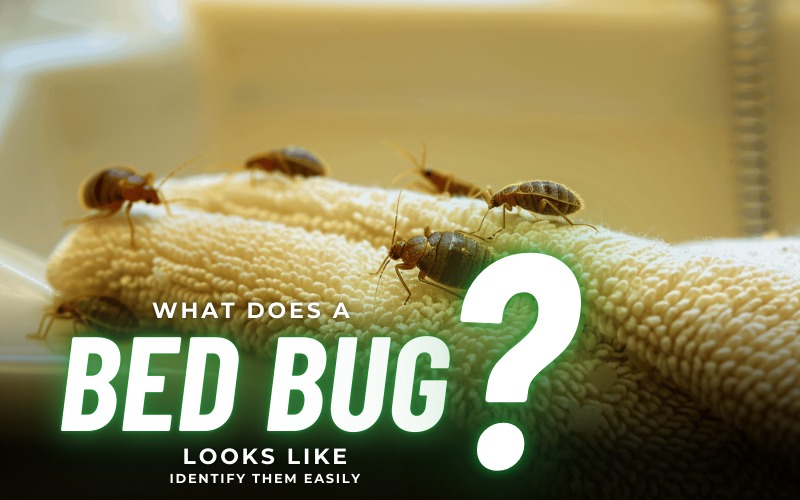Table of Contents
ToggleIf you’ve ever wondered, “What does a bed bug look like?” you’re not alone. Bed bugs can be tricky to identify, yet spotting them early is essential for effective pest control. In this guide, we’ll help you recognize what bedbugs look like by detailing their size, shape, color, and even behavior, so you can take the right steps to manage and eliminate them. Whether you’re dealing with a possible bed bug sighting or just want to be informed, here’s everything you need to know about identifying bed bugs.
Understanding the Appearance of Bed Bugs
In order to determine the presence of bed bugs, people have to be familiar with how these insects look. The exterior of Bed bugs is petite and flat-oval shaped, and the length of an adult bug is approximately 4-5mm. It has flat, reddish-brown bodies resembling an apple seed, and it is usually about the same size as a grain of rice as the bed bugs. When full fed they become obese and have a blackish red appearance of their bodies.
Bed bugs have well developed three-segmented antennae, three pairs of legs and they do not possess wings unlike those of house crumbs. Due to their size, they are usually able to blend in small spaces such tight crevices and this is why early detection is paramount when it comes to eradication of the pests.
How to Spot Bed Bug Eggs
The eggs are small white specks, often no more than the size of a head of a pin. They are normally placed in areas, which are dark, or where insects such as bed bugs tend to harbor. The bed bug eggs are very camouflaged because they are sticky and once you get familiar with the look of the eggs you would easily see them. The prevention of eggs that have hatched to bed bugs may seem to be very important when it comes to bed bugs.
Common Signs of Bed Bugs in Your Home Living Space
Here are some easy bed bugs signs that may be in your home:
- Bites on Your Skin: Common signs of these bites are; clustered or one after the other in lines and are usually red, swollen and itchy and favor areas such as the arms, neck, and face. Such bites are as a result of bed bugs feeding on your blood at night when you are asleep.
- Blood Stains on Bedding: This is more likely to be small dots of blood on your linen, on the pillow case or around the borders of your mattress. They are accomplished when bed bugs feed and are particularly squashed every time you shift during sleep.
- Dark Spots or Fecal Matter: The bed bug fecal matter is small, dark moving specks often found on bed linen or covers, mattresses or walls where bed bugs are likely to be lurking. These areas are indicative that the bugs feed and can breed in these areas.
- Discarded Shells and Eggs: When bed bugs mature they are metamorphic and leave behind exoskeletons around sites where they might be hiding. They may also drop small white eggs or eggshells on floors, walls or crevices.
- Musty Odor: That is why, as the population increases, there may be a strong, musty odor. This odor is from bed bug’s smell producing glands and tends to intensify, especially given the presence of many bugs.
If any of the above indications is observed, it is advisable to get the situation remedied before the population increases exponentially.
How to Differentiate Bed Bugs from Similar Pests
These are the key ways to differentiate bed bugs look alike from similar pests commonly found in homes:
Carpet Beetles:
Carpet beetles are small, oval shaped with a brownish color dotted with white or black patches with a hard outer covering. They do not bite and are mostly found close to carpets, pieces of furniture, windows or even window sills.
Fleas:
They are small and of slim body build and they are capable of jumping. They are mostly found to be biting around the lower legs of the body, around ankles; they are common with pets or in areas where the pet may lie.
Cockroaches:
Cockroaches are smaller than bed bugs and have a more oval shape with shiny, more robust bodies than their skinny counterparts. Okay, they are fast movers usually found in the kitchen or the bathroom and not in the beds as most people think.
Ticks:
Ticks are larger, more circular and feed on skin by attaching itself to it. They do not often linger in bedding but can be detected on pets or on lawns outside the house.
Conclusion:
Although bed bugs are not an easy bug to diagnose, anyone who wants to keep their home free of these small creatures must know what bed bugs look like. These must be occasions where a client realizes the appearance of the bed bugs, or instances where they notice incoming signs of an even bigger infestation ahead. In case you have bed bugs in your house, contact Vanquish Pest Control for professional service and solution to your problems. To get more information and start on the road to eradicating bed bugs, visit Vanquish Pest Control today.
Frequently Asked Questions
What does a bed bug bite look like?
Bed bug bites look like small, red, itchy bumps, often in clusters or lines. They usually occur on exposed areas like the arms, neck, or face.
Can you see bed bugs with the naked eye?
Yes, adult bed bugs are visible to the naked eye and are about the size of an apple seed. Younger bed bugs and eggs are smaller and harder to spot.

